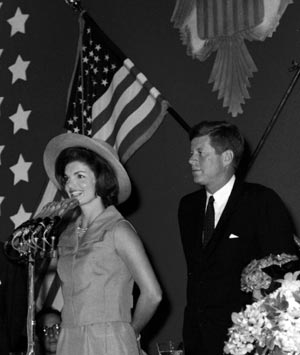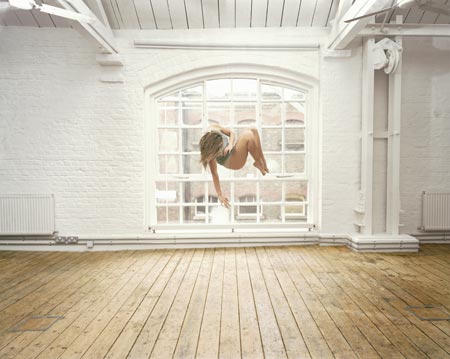Jackie Kennedy at the Field Museum
Debra N. Mancoff
As we were leaving a preview showing of the current Field Museum exhibition Jacqueline Kennedy: The White House Years, (open through May 8th) a friend shared a mischievous notion: “Forty years from now, can you imagine a retrospective exhibition of Laura Bush’s wardrobe?” The prospect raised a cynical laugh; a display of our current First Lady’s lackluster garments, draped on Laura-shaped mannequins, seemed more like satire than style when compared to the dazzling and glamorous installation of Jacqueline Kennedy’s “State Wardrobe.” But there was a serious challenge at the core of his question, and it prompted me to reflect, why, beyond the issue of celebrity, we should care so much about Mrs. Kennedy’s clothes.
There is no denying that the substance of this exhibition is Jackie’s style. In an intelligent and lucid installation, the exhibition, originally curated by Hamish Bowles for the Metropolitan Museum of Art and the John F. Kennedy Library and Museum, traces the four years, from JKF’s campaign for the Presidency to the abrupt and tragic end of his administration, during which the Kennedy’s dominated the American imagination. The garments worn by Jacqueline Kennedy on the campaign trail, to state events, and on her goodwill tours to Europe, India, Pakistan, and South America, wind like a glittering thread through the exhibition’s narrative. More than just a costume show, the exhibition opens a door on an optimistic era, when the notion of American identity was being recast in a young, sophisticated, and openly international image.
The exhibition team (designer Teresa Murray, graphic designer Lori Walsh, and lighting designer Trig Waller) collaborated to create a fresh, but neutral, installation of the garments on minimalist mannequins in well-designed vitrines. Interested visitors can view not only the front of a design, but also the intricate back details, the half belts, the little bows, the complex fastenings, that enhanced the stark simplicity of the “Jackie style.” But there is so much more to consider than the clothes: newsreels of the campaign, the Inaugural address, the Good Will Tours, and the televised White House Tour play in endless loops in individual galleries. There is an abundance of ephemera, including campaign novelties ranging from buttons to a “Kennedy Girl” dress (a red, white, and blue shirtwaist with the candidate’s name on the cumberbund), to seating arrangements for formal dinners, and tour agendas with Jacqueline Kennedy’s own notations. State gifts, such as a silver model of the Shalimar Gardens in Pakistan, a painted plaque proclaiming Jacqueline Kennedy as the “Supersonic First Lady of the USA” from the Children’s Museum in Amreli, India, and a sumptuous bolt of satin brocade from the King of Saudi Arabia, which Jacqueline Kennedy gave to designer Joan Morse to turn into the skirt and caplet of an uncharacteristically flamboyant gown, are also on display. It is a diverse mix, and it is to the credit of Production Manager Nel Fetherling and Project Administrator Todd J. Tubutis that the wealth of distracting curiosities never obscures the narrative. A visitor comes away with a sense of the promise of the Kennedy administration, an enthusiastic image of a post-war America, ready to take on an expanded role in a changing world.
The exhibition might be faulted for this unrelentingly nostalgic vision of Kennedy’s America as an endorsement without a critique. But seeing the exhibition just one week after the recent election was a poignant reminder of a time when the man and the woman who represented our nation did not deny their fine educations, intellectual interests, and the central significance of culture, old and new, in a widening world. In one of the last galleries, a pair of trompe l’oeiI doors, painted for the wardrobe in Jacqueline Kennedy’s White House dressing room by Pierre-Marie Rudelle for the Parisian design firm Jansen, features what she called “mes objects ador³es.” Among images of family photographs and campaign memorabilia are a number of images of books, including JFK’s Profiles in Courage and Charles Baudelaire’s Les Fleurs du Mal. Imagine! Just four decades ago we had a First Lady who wasn’t afraid of the French! Looking at those charming doors, I recalled with sadness Diana Vreeland’s comment on the Kennedy’s White House years in her autobiography. According to D.V.: “The Kennedys released a positive attitude toward culture, toward style…and, since then, we’ve never gone back.”
It’s a good thing that the doyenne of American fashion did not have to see her words contradicted by the current administration’s attitude toward culture and the arts. And that’s why we want to see Mrs. Kennedy’s clothes; we yearn for the substance that supported the style.
Debra N. Mancoff is an Adjunct Associate Professor in the Department of Art History, Theory and Criticism
Related Links: www.fieldmuseum.org
Images courtesy of the © JFK Library and Museum
December 2004









